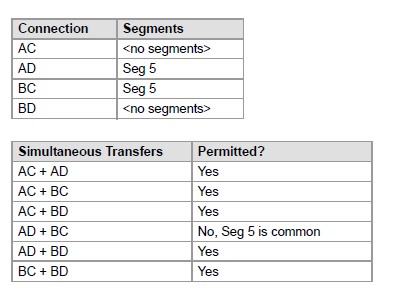Example 1

- Notice, we have successfully prevented the simultaneous transfers of material AD and BC while allowing AC and BD.
- This result is desired, but what about the other 4 combinations. We have prevented them as well.
- In some batch processes this may be desirable, in others it may not.
- For instance, why not allow unit A to transfer to both C and D simultaneously? Even if C and D are allocated by different batches, unit A may contain a Bulk material needed by both batches.
- The source unit in a transfer need not be allocated by InBatch in order to perform the transfer.
- This capability is provided specifically for Bulk ingredient transfers.
- Redefine the model. For this time only, model Seg 5 to see what effect this has on our allowable simultaneous transfers.

- Notice that AD + BC is still prevented but all other combinations are permitted.
- We have successfully prevented only the one undesirable combination from occurring simultaneously.
- This result illustrates our first rule of modeling segments.
- Rule 1: Only model those segments that will prevent specific undesirable combinations of transfers from occurring simultaneously.
- It may, in some cases be desirable to prevent other combinations of simultaneous transfers in this example. These limitations are usually dependent on if and how materials are metered.
Last modified: Saturday, 2 May 2020, 10:17 AM
